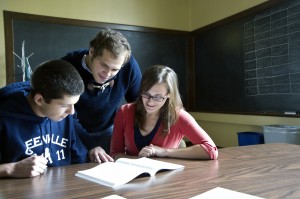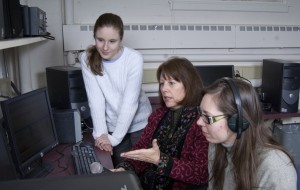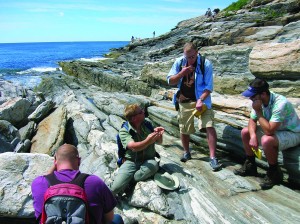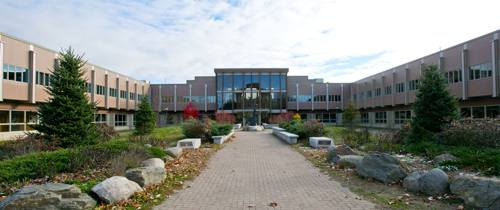Annual Update from the College of Natural Sciences, Forestry, & Agriculture
I. Introduction
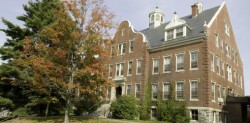 The College of Natural Sciences, Forestry and Agriculture (NSFA) has a three-part mission—education, research, and service—covering a range of areas within the natural sciences, forestry, and agriculture. We offer 28 undergraduate majors, 14 Ph.D. programs, 24 M.S. degree programs, and six Master of professional studies programs that provide students with a wide range of educational opportunities. In AY 2012–2013, total student enrollment exceeded 2895 and was the largest among UMaine’s colleges. Our incoming class for fall 2012 was 22% larger than the prior year and ranked first among UMaine’s five academic colleges.
The College of Natural Sciences, Forestry and Agriculture (NSFA) has a three-part mission—education, research, and service—covering a range of areas within the natural sciences, forestry, and agriculture. We offer 28 undergraduate majors, 14 Ph.D. programs, 24 M.S. degree programs, and six Master of professional studies programs that provide students with a wide range of educational opportunities. In AY 2012–2013, total student enrollment exceeded 2895 and was the largest among UMaine’s colleges. Our incoming class for fall 2012 was 22% larger than the prior year and ranked first among UMaine’s five academic colleges.
The faculty in our 13 academic units (Departments: Animal & Veterinary Sciences [AVS], Communications Sciences & Disorders [CSD], Food Science & Human Nutrition [FSHN], Molecular & Biomedical Sciences [MBS], and Plant, Soil, & Environmental Sciences [PSE], Schools: Biology & Ecology [SBE], Earth & Climate Sciences [ERS], Economics [SOE], Forest Resources [SFR], Marine Sciences [SMS]; Nursing [SON], and Social Work [SSW]) were involved in cutting-edge research on diverse topics including earth and environmental sciences, marine sciences and policy, sustainable forestry and natural resource management, food and agricultural sciences, economics and social sciences, health sciences, and basic life sciences. Members of our faculty are also active members of several prominent research centers on campus including the Climate Change Institute, Forest Bioproducts Institute, Center on Aging, Advanced Structures and Composite Center, George J. Mitchell Center, Aquaculture Institute, Center for Community Inclusion and Disability Studies, among others. Our college contains all of the University of Maine’s AAAS Fellows (you can read more about them here). Our faculty, staff and students are also active in outreach throughout Maine and serve our citizens in numerous ways consistent with our land-grant and sea-grant mission.
II. Major Goals Accomplished as Related to the Strategic Goals of UMaine’s Blue Sky Project
Goal 1. Serve Our State
- The Maine Agricultural and Forest Experiment Station (MAFES) conducted research to support Maine’s natural resource based industries. MAFES also actively worked with UM Cooperative Extension to engage these industries.
- NSFA faculty, staff, and students engaged with Maine’s legislature and government agencies in numerous ways including testimony, legislative tours, meetings, advisory committees, service on boards, among others.
- NSFA partnered with more than 30 Maine companies and organizations on research projects.
- The SOE leadership on the Knowledge Transfer Alliance has fostered the success of several start-up companies.
- Faculty in the SSW and the Center on Aging are working with local communities on a project to assist families with substance abuse problems. This five-year $4M project is funded through the Children’s Bureau.
- NSFA is establishing new internship opportunities with Maine businesses. We developed a model that involves paid intern experiences and linked scholarship support. Our first such partnership is with Stantec, an environmental consulting firm.
- NSFA/MAFES developed a partnership with the agricultural experiment stations at the University of New Hampshire and University of Vermont to establish the Northern New England Collaborative Research Funding Program. The goal is to catalyze coordinated regional research on high-priority needs for the northern New England region in experiment station mission areas. The program awards seed grants to regional research teams through an annual competition. The first seed grant award was made in 2013.
- MAFES entered into an agreement with the Maine Potato Board to jointly license new potato variety releases from our potato research program.
Goal 2. Secure Financial Stability
- NSFA is working to increase tuition revenue. The incoming fall 2012 class was up by 22% and accounted for more than 44% of the total university increase. Fall 2013 first-year enrollment, will be up another 10% giving the college a 34% increase in the last two years. In doing so, the college has maintained quality as measured by SATs and class rank. During this time period, the college has also increased the percentage of non-resident first-year students. Non-resident students will comprise approximately 43% of our fall 2013 incoming class.
- NSFA’s most recent four-year and six-year graduation rates are 40% and 66% as compared to 37% and 59%, respectively, for the University of Maine.
- NSFA generated >$17M of sponsored funding, >$867K in industrial support and received more than $3M in federal formula funds in FY2013. This >$21M in external funding for research enhances our programs.
- An interprofessional graduate certificate program in gerontology was developed and approved in March 2013. Two of the five courses have been offered and the remaining three courses will be offered in 2013–14. This is a collaborative effort among four professional programs—SON, SSW, CSD, and FSHN.
Goal 3. Embrace a Culture of Excellence
- Three departments—AVS, FSHN, and PSE—were merged into the new School of Food and Agriculture (SFA). This merger should provide both programmatic and administrative improvements.
- In response to a departmental review, the Department of Earth Sciences revised its curricula and changed its name to the School of Earth and Climate Science to reflect changing programs and opportunities.
- Operations of the Conley Clinic were separated from academic operations of CSD. This separation between client data and academic operations was required to meet HIPPA regulations.
- NSFA faculty were active scholars and published 316 refereed publications, 184 other publications and gave over 700 professional presentations.
Goal 4. Strengthen the UMaine Student Experience
- The college continues to look for better ways to serve and interact with our students. We have maintained and improved our first-year seminars, the Forest Explorations program, and the Schoodic Experience, increased hands-on experience and travel opportunities, increased the number of inquiry-based labs, and continued our S3 Program (Support for Sciences Living Learning Program) which has an 84% retention rate. Throughout the college, units are revising curriculum and improving assessment in an attempt to maintain or improve quality.
- SON faculty completed a significant revision of the baccalaureate program of study. The fall 2012 incoming-class was admitted into the revised curriculum.
- SBE faculty have fully incorporated inquiry-based laboratories into introductory courses for both majors and non-majors. SBE is recognized as a leader in science education.
- Dr. Eric Gallandt (PSE) with sustainable agriculture (SAG) and environmental horticulture (ENH) undergraduates established UMaine Greens, an initiative to grow greens on campus and sell them to UMaine Dining Services. This project brings real-world experience of planning, production, washing and packing, marketing and sales, to students, who can participate through much of the academic year. The program has been enthusiastically received by Dining Services, which has committed funding to build a second greenhouse this summer.
- SOE augmented its capacity in renewable energy teaching and research. Three minors in renewable energy were developed: renewable energy engineering, renewable energy science and technology, and renewable energy economics and policy. There are 46 students presently enrolled. SOE also developed a concentration in renewable energy within the BA/BS in Economics.
Goal 5. Renew Our Infrastructure
- A major exterior renovation of Nutting Hall was completed, greatly improving the exterior appearance of the building, and substantially increasing the energy efficiency and comfort of students, staff, and faculty.
- The Barbara Wheatland Geospatial Analysis Laboratory was established. It was funded by an endowment from the Maine Timberlands Charitable Trust to SFR.
- Two teaching labs, a lecture room and two research laboratories were renovated in Deering Hall.
- An underused and outdated research laboratory was converted into a new landscape design studio in Rogers Hall.
- Renovation of a WLE teaching laboratory, research laboratory and graduate student office area was completed in Nutting Hall.
- Renovation of an off-campus WLE field equipment storage facility was completed.
- Renovations to improve plant science teaching and research capabilities in the Clapp Greenhouse and Littlefield Gardens were completed.
- MAFES invested in roof and road improvements at the Witter Center, building and energy-efficiency improvements at Highmoor Farm, and energy-efficiency improvements to a greenhouse at Aroostook Farm. Our continued investments in energy efficiency have led to significant returns.
- The Harold L. Chute, DVM, Center for Equine Research and Education was constructed at the Witter Center. Funds for the building came from Dr. Chute’s family, other private donations, and a grant from the Maine Technology Asset Fund. This initiative was led by Dr. Robert Causey.

III. Identification of Major Challenges in Meeting Goals and Status of Unmet Goals
- Continued efforts to increase enrollment and improve retention to enhance tuition revenue and academic success
- Provide high-quality student experience to more students with fewer faculty
- Secure external grants and contracts in present fiscal climate
- Renew infrastructure to support education and research programs
- Renew our aging faculty
- Continuing improvement of policies and practices to improve efficiency
IV. Noteworthy Divisional/Unit Points of Pride Emerging in 2012–2013.
- Master of Social Work (MSW) graduates continue to exceed pass rates for the national licensing exams by a significant margin. In 2012, 94% of graduates passed the LMSW exam compared to 72% nationally; 87% passed the LCSW exam compared to 66% nationally.
- The National Science Foundation ranked Earth Sciences at the University of Maine as being in the top 30 programs in the country. The ranking was based on research expenditures.
- A team of MSW students and Dr. Jennifer Middleton received the 2013 President’s Impact Award for the research project: What Happens Next? Examining Child Protection Outcomes in a Cohort of Opioid-Exposed Infants.
- Dr. Rhian Waller was featured in the March 2013 issue of National Geographic.
- Several NSFA undergraduate students published peer-reviewed journal publications with their faculty mentors.
- In 2013, NSFA students were selected as both the valedictorian and salutatorian. Spencer Hathaway, a double major in economics and accounting (College of Business) was the valedictorian and Lindsay LaJoie, majoring in food science and human nutrition was the salutatorian.
- In the most recent rankings of the US New and World Report, ERS was ranked higher against national peers than any other ranked graduate program at the University of Maine.
- The Dietetics Program has a 94% five-year average pass rate on the registered dietitian exam.
- All graduates of CSD’s master’s in speech-language pathology passed the national Praxis Test. The national pass rate is currently 86%.
- The SON pass rate for the RN national licensure exam has remained at or above the national average for three years (6 graduating cohorts). The 2012-13 first attempt pass rate was 97%. The December 2012 graduating cohort achieved a 100% pass rate. Unfortunately, preliminary indications indicate less success for our May 2013 graduates.
- The May 2012 graduates of the MSN family nurse practitioner program had a 100% first-attempt pass rate on the national certification examination. Results from May 2013 are not available yet.
- The Conley Speech, Language and Hearing Center served approximately 450 patients during the past year. The clinic provides clinical experiences for CSD students.
- A job placement survey of 100 SFR alumni from the past decade found that 57% had a forest resources-related job prior to graduation; 92% received a job in a forest resources-related field within one year of graduation; and 18% of undergraduate alumni reported going to graduate school.
V. Noteworthy Efforts to Increase Revenue, Decrease Expenditures, and Increase Fiscal Efficiency
a. Increase tuition revenue:
- The college increased tuition revenue by attracting more students, attracting more out-of-state students and recruiting more international students into our programs. Included among the latter efforts were formal establishment of exchange programs with several Chinese Universities that will bring students into our Marine Science, Social Work and Economics programs. The first of these students are currently in residence.
- The SSW’s Weekend MSW Distance Cohort Model continues to attract graduate students. The use of video-conference technology brings the Weekend MSW program to three diverse areas of the state: Belfast, Falmouth and Presque Isle. We will continue with planning for a new cohort (and possibly new locations) for entry in fall 2015.
b. Increase research support:
- NSFA generated $17.2M of sponsored funding in FY13. This is slightly higher than last year ($16.9M) and close to our 5-year average. The largest sponsor was NSF (28%) followed by USDA (19%), NASA (15%) and the Department of Commerce. Overall, 89% of the awards were from federal sources, 5% from the state of Maine, and 6% from foundations and private sources. Considering the impact of “sequestration” and budget cuts, our level of success this year is encouraging. NSFA led all Colleges in sponsored funding and indirect cost recovery.
- SMS again brought in the highest total extramural funds ($5.6M). Six other NSFA units (PSE, SBE, ERS, SOE, SFR, WLE) were each awarded >$1M in external support.
- NSFA faculty were successful in obtaining >$867K in industrial support.
- Total NSFA annual external support for research exceeds $20M, with formula funds included.
c. Increase private support
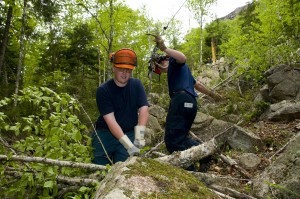 NSFA and associated units received significant private support (>$1M) during the past year for scholarships, professorships, internships, endowments, gifts-in-kind and discretionary funds. Among the noteworthy donations:
NSFA and associated units received significant private support (>$1M) during the past year for scholarships, professorships, internships, endowments, gifts-in-kind and discretionary funds. Among the noteworthy donations:
- SOE received a generous contribution of $250,000 from the Farm Credit of Maine to partially support a named professorship in production economics and agricultural finance.
- SFR received support from the USDA Forest Service for 50% of a new faculty position in “carbon and climate.”
- The Maine Timberlands Charitable Trust provided SFR with $250,000 to partially support a professorship in GIS. This organization also donated >$200K to establish The Barbara Wheatland Geospatial Analysis Laboratory, which was dedicated on April 23, 2013.
- Stantec Corporation established an internship and scholarship program to support wildlife ecology and ecology & environmental sciences students.
d. Decrease expenditures and increase fiscal efficiency:
- Use of undergraduate teaching assistants—Increased enrollment in several laboratory courses and an insufficient and fixed number of TAs available through the Graduate School has led to several units recruiting upper-level undergraduate as teaching assistants. SBE has also been employing undergraduates as “coaches” to facilitate student success.
- Review administrative processes to increase efficiency—Ms. Susan Gallant initiated and led monthly administrative staff meetings involving NSFA administrative assistants. These meetings serve as a forum for general updates and sharing of best practices. Detailed training sessions to improve processes have been conducted.
- Continuing efforts to improve energy efficiency at MAFES farms and facilities: The college made recent strides on sustainability initiatives at two off-campus research facilities during the past year: energy-efficiency improvements to a greenhouse at Aroostook Farm and insulation improvements at the office building at Highmoor Farm. These and earlier energy-efficiency projects have yielded substantial savings to date.
- The Conley Clinic increased the number of clients seen and the rate at which graduate students earn their clinical hours. Revenue increased by approximately $50,000. Unfortunately, the Clinic continues to run a deficit and is subsidized by the Conley Endowment. We will continue to work on this issue.
- Merger of three departments to create the School of Food and Agriculture will offer greater efficiency by reducing the service load on faculty. We further aim to improve efficiency of our administrative professionals and staff through a higher-level specialization of tasks relating to undergraduate student services, personnel, purchasing, and account management.
VI. Personnel Changes Within NSFA Faculty and Administration
- We hired 8 new faculty members in AY2012–2013. These individuals assumed positions within Molecular and Biomedical Sciences (2), Food Science and Human Nutrition (2), Forest Resources, Economics and Nursing (2).
- We hired 13 new faculty members in AY2013-2014. These individuals assumed positions within Biology and Ecology (2), Marine Sciences (2), Economics, Forest Resources (2), Social Work, Nursing, Food and Agriculture (2), and Wildlife Ecology (2). While we have experienced a net loss of tenure-stream faculty over the past decade, we are pleased to replace most retiring and departing faculty members with new colleagues.
- All seven NSFA candidates for promotion were successful.
- The leadership in five academic units changed in the past year as well as the Director of the Darling Marine Center. These changes were the result of terms expiring and one phased retirement.
VII. Noteworthy Recognition and Achievements of NSFA Faculty
- Drs. Joyce Longcore and Susan Brawley were elected Fellows of the American Association for the Advancement of Science (AAAS).
- Dr. Christopher Gerbi was selected by the National Academy of Sciences to be a Kavli Fellow and participate in the Kavli Frontiers of Science Program. Since its inception, 136 Kavli program “alumni” have been elected to the NAS. Dr. Gerbi is in the second year of his CAREER Grant from the National Science Foundation. These awards are among the most prestigious offered by NSF.
- Dr. Frank Drummond was awarded the 2013 Presidential Research and Creative Achievement Award and was selected as the 2013 Ledermann Distinguished Lecturer at the University of Rhode Island.
- Dr. Dusty Dowse received the NSFA 2013 Teaching Excellence Award.
- Dr. Ellie Groden received the NSFA 2013 Outstanding Public Service Award.
- Dr. Peter Koons received the NSFA 2013 Outstanding Research Award
- Dr. Gayle Zydlewski received the NSFA Graduate Mentor of the Year Award.
- Dr. Paul Mayewski was made Honorary Member of the American Polar Society.
- Dr. M. Susan Erich received a fellowship through the Invitation Fellowship Program for Research in Japan, Japan Society for the Promotion of Science, which enabled her to spend 10 weeks (Feb.–April, 2013) in Tsukuba, Japan, conducting research on soluble carbon in andisols.
- Dr. Andrei Alyokhin received Special Recognition for Outstanding Support and Contributions by the National Park Service.
- Dr. Edward Grew, an internationally recognized mineralogist and research professor in ERS, was given the rare and prestigious honor of having two newly discovered minerals named after him, edgrewite and hydroxyledgrewite.
- Dr. Linda Silka (SOE, MCSPC) was the project facilitator of the Blue Sky Project.
- Dr. Gail Werrbach was appointed as one of five commissioners to the first Truth and Reconciliation Commission on child welfare in the United States. Over the next two years, the commission will meet with each of Maine’s Tribal communities to hear community members’ testimony about what happened to them with Maine child welfare.
- Dr. Douglas Gardner was elected a Fellow of the Society of Wood Science and Technology.
- Dr. Robert Steneck had two papers recognized by the Faculty of 1000.
- Drs. Emmanuel Boss and Lee Karp-Boss are participating in the Tara Oceans Polar Circle Expedition 2013 during the summer, an international research collaboration that studies Arctic planktonic ecosystems in the context of climate change. Two SMS graduate students, Alison Chase and Thomas Leeuw, will also join the expedition on the schooner for two months.
- Dr. Kathleen Bell received the Soren Wibe Prize (joint with Chris Moore and Thomas Holmes) for their article published in the Journal of Forest Economics.
- Ms. Judith Stickles received the Seventh Ace Award for Continuing Education from the American Speech Language and Hearing Association.
- Dr. Jeffrey Benjamin received the 2012 Outstanding Service to the Industry Award from the Northeastern Loggers’ Association.
- Dr. Sharon Klein (Wagner) was recognized as a “Champion of Change” during a Washington D.C. event to recognize AmeriCorps alumni who have leveraged their national service experience to become influential leaders in their communities.
- Dr. Joseph Kelley serves on the McArthur Foundation “Genius” Award Nomination Committee.
- Dr. Andrew Pershing testified to Congress on the value of considering climate change in fisheries management.
- Dr. Elizabeth DePoy was awarded a University of Maine System Trustee Professorship to support her research on disabilities studies.
- Dr. Judy Walker led the development of a Speech Therapy Telepractice and Technology program. This intensive May term training course was taught to 14 students. Three clients in Maine and three in Fiji were seen. The program will be expanded to other schools and health centers, particularly rural areas of Maine.
VIII. Summary of Program Reviews for 2012–2013
- The Didactic Program in Dietetics and the Dietetic Internship Program both received accreditation from the Accreditation Council for Education in Nutrition and Dietetics (ACEND).
- SFR received high marks from a ten-year professional accreditation review of its three undergraduate degree programs and master of forestry graduate program by a Society of American Foresters review team.
- SFR new Forest Operations, Bioproducts, & Bioenergy degree program was also professionally accredited by the Society of Wood Science and Technology.
- SSW received affirmation of accreditation from the Council on Social Work Education Commission on Accreditation (COA) for both the BSW and MSW programs for the full eight years.
- CSD integrated new courses into a revised curriculum, as suggested in accreditation reviews of our undergraduate and graduate programs. Continued concern by the accrediting agency regarding the number of tenure-stream faculty remains.
- SMS and the Lobster Institute will be reviewed in the coming year.


